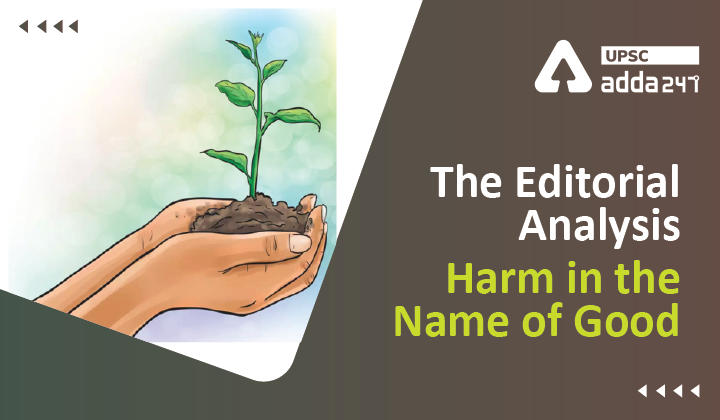Table of Contents
Harm in the Name of Good- Relevance for UPSC Exam
- GS Paper 3: Environment- Conservation, environmental pollution and degradation.
Harm in the Name of Good in news
- The UN General Assembly has proclaimed March 21 as the International Day of Forests to celebrate and raise awareness about the importance of forests.
- On this day, countries are encouraged to organise activities such as tree-planting campaigns to help increase the green cover, conserve biodiversity, and fight climate change.
Issues with Present Plantation Drives
- Lack of Ecosystem Approach: Forests are complex ecosystems that are built over years due to the interplay of birds, mammals, reptiles, insects, amphibians, fungi, microorganisms, water, soil, environmental conditions, and other factors.
- Unless these players are part of the rebuilding process, trees will remain as green cover rather than the enchanting, natural, complex ecosystems that they are.
- Destruction of Ecologically Rich Habitats: If wrong areas are selected for plantation, the natural habitat may get altered, which will cause habitat specialist species to become extinct.
- This will make the local environment and ecosystem less resilient.
- A classic example that we witness is the conversion of natural grasslands to wooded areas through tree planting.
- The Great Indian Bustard, once nominated to be India’s national bird, is now staring at extinction with fewer than 200 individuals.
- This is because many areas where these large birds thrived have been lost due to tree planting.
- The Ranibennur Wildlife Sanctuary in central Karnataka, which was designated to conserve this species, is an example of this unscientific thinking.
- The Jayamangali Conservation Reserve, another grassland habitat in Karnataka, hosted wolves.
- But now there are leopards there as the whole area has been planted with acacia, anjan, eucalyptus and tamarind trees.
- Faulty Plantation Drives: Some of these tree-planting campaigns claim to propagate native species. Native tree species is a very misused terminology in India.
- Though neem, peepal, banyan, and anjan may be native to India, they are non-native to many parts of the country.
- We tend to ignore this critical ecological criterion and take up planting of these species in all areas.
- Planting any kind of native tree species may probably help in urban settings but not in natural habitats.
Amazon Rainforest Reaching Tipping Point
Restoring Natural Ecosystem of Forests
- Making tree-planting activities friendly to local biodiversity: If we want to restore forests, we need to first understand systematically the native vegetation and the biodiversity that play a critical role in forming these forests.
- If we plant a range of locally found indigenous species, biodiversity will make a comeback.
- There is a rule of thumb in the tree-planting world: One should plant the right tree in the right place. And some add, ‘for the right reason’.
- Monitoring the effectiveness: We should also monitor and examine the outputs of such tree-planting or restoration initiatives.
- Promoting Assisted Natural Regeneration: Another solution is to let forests come back on their own through protection. This is called assisted natural regeneration and is cheaper and more effective method.
- Scientific studies have shown that natural regeneration absorbs 40 times more carbon than plantations and hosts a lot more biodiversity.
- Preserving Existing Biodiversity and Forest Ecosystems: Our utmost priority is the task of halting deforestation and protecting existing forests.
- Investing in Forestry and Wildlife Conservation: A report by the Centre for Science and Environment says that the government has cut the budget for wildlife conservation by 47% between 2018 and 2021.
- The government ought to increase its support for forests and other habitat protection.
India State of Forest Report 2021





 TSPSC Group 1 Question Paper 2024, Downl...
TSPSC Group 1 Question Paper 2024, Downl...
 TSPSC Group 1 Answer key 2024 Out, Downl...
TSPSC Group 1 Answer key 2024 Out, Downl...
 UPSC Prelims 2024 Question Paper, Downlo...
UPSC Prelims 2024 Question Paper, Downlo...
